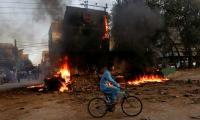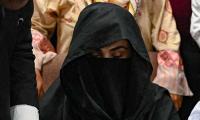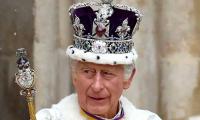MOSCOW: Vladimir Putin is open to discussing a Ukraine ceasefire deal with Donald Trump but rules out making any major territorial concessions and insists Kyiv abandon ambitions to join NATO, five sources with knowledge of Kremlin thinking told Reuters.
U.S. President-elect Trump, who has vowed to swiftly end the conflict, is returning to the White House at a time of Russian ascendancy. Moscow controls a chunk of Ukraine about the size of the American state of Virginia and is advancing at the fastest pace since the early days of the 2022 invasion.
In the first detailed reporting of what President Putin would accept in any deal brokered by Trump, the five current and former Russian officials said the Kremlin could broadly agree to freeze the conflict along the front lines.
There may be room for negotiation over the precise carve-up of the four eastern regions of Donetsk, Luhansk, Zaporizhzhia and Kherson, according to three of the people who all requested anonymity to discuss sensitive matters.
While Moscow claims the four regions as wholly part of Russia, defended by the country’s nuclear umbrella, its forces on the ground control 70-80% of the territory with about 26,000 square km still held by Ukrainian troops, open-source data on the front line shows.
Russia may also be open to withdrawing from the relatively small patches of territory it holds in the Kharkiv and Mykolaiv regions, in the north and south of Ukraine, two of the officials said.
Putin said this month that any ceasefire deal should reflect the “realities” on the ground but that he feared a short-lived truce which would only allow the West to rearm Ukraine.
“If there is no neutrality, it is difficult to imagine the existence of any good-neighbourly relations between Russia and Ukraine,” Putin told the Valdai discussion group on Nov. 7.
“Why? Because this would mean that Ukraine will be constantly used as a tool in the wrong hands and to the detriment of the interests of the Russian Federation.”
Two of the sources said outgoing U.S. President Joe Biden’s decision to allow Ukraine to fire American ATACMS missiles deep into Russia could complicate and delay any settlement - and stiffen Moscow’s demands as hardliners push for a bigger chunk of Ukraine. On Tuesday, Kyiv used the missiles to strike Russian territory for the first time, according to Moscow which decried the move as a major escalation.
If no ceasefire is agreed, the two sources said, then Russia will fight on.
“Putin has already said that freezing the conflict will not work in any way,” Kremlin spokesman Dmitry Peskov told Reuters hours before the Russians reported the ATACMS strikes. “And the missile authorisation is a very dangerous escalation on the part of the United States.”
Ukrainian President Volodymyr Zelenskiy has said his country will not rest until every last Russian soldier is ejected from its territory - based on the borders it gained after the 1991 fall of the Soviet Union - though top U.S. generals have said publicly that this is a very ambitious aim.
On June 14, Putin set out his opening terms for an immediate end to the war: Ukraine must drop its NATO ambitions and withdraw all of its troops from the entirety of the territory of four Ukrainian regions claimed and mostly controlled by Russia.
While Russia will not tolerate Ukraine joining NATO, or the presence of NATO troops on Ukrainian soil, it is open to discussing security guarantees for Kyiv, according to the five current and former officials.
Other Ukrainian concessions the Kremlin could push for include Kyiv agreeing to limit the size of its armed forces and committing not to restrict the use of the Russian language, the people said.
Dimitri Simes, who emigrated to the United States from the Soviet Union in 1973 and is one of Russia’s best-connected experts on America, said a ceasefire agreement could be struck relatively swiftly to end the war.
But a wider, lasting deal that addressed both Ukraine and Russia’s security concerns would be extremely challenging to forge, he added.
Russia controls 18% of Ukraine including all of Crimea, a peninsula it annexed from Ukraine in 2014, 80% of the Donbas - the Donetsk and Luhansk regions - and more than 70% of the Zaporizhzhia and Kherson regions. It also holds just under 3% of the Kharkiv region and a sliver of Mykolaiv.
Domestically, Putin could sell a ceasefire deal that saw Russia hold onto most of the territory of Donetsk, Luhansk, Zaporizhzhia and Kherson as a victory that ensured the defence of Russian speakers in eastern Ukraine and safeguarded the landbridge to Crimea, according to one of the sources.
The future of Crimea itself is not up for discussion, all the Russian officials said.
When asked what a possible ceasefire might look like, two of the Russian sources referred to a draft agreement that was almost approved in April 2022 after talks in Istanbul, and which Putin has referred to in public as a possible basis for a deal.
Under that draft, a copy of which Reuters has seen, Ukraine should agree to permanent neutrality in return for international security guarantees from the five permanent members of the U.N. Security Council: Britain, China, France, Russia and the United States.
One of the Russian officials said there would be no agreement unless Ukraine received security guarantees,.
Representational image of empty streets and closed shops in central Maputo ahead of a ruling on disputed elections on...
The flag of Serb Republic on a building in East Sarajevo, Bosnia and Herzegovina, January 9, 2023. —...
US President Joe Biden speaks as he visits the Department of Labor for an event honoring the nation's labor history...
Japanese foreign minister Takeshi Iwaya pictured in a Christmas event in Beijing. — AFP/FileBEIJING: Japanese...
A woman shovels snow on the main street during snowstorm in Sarajevo, Bosnia and Herzegovina, December 24, 2024.—...
A firefighter works at the site of residential buildings hit by a Russian drone strike in Kharkiv, Ukraine on December...







